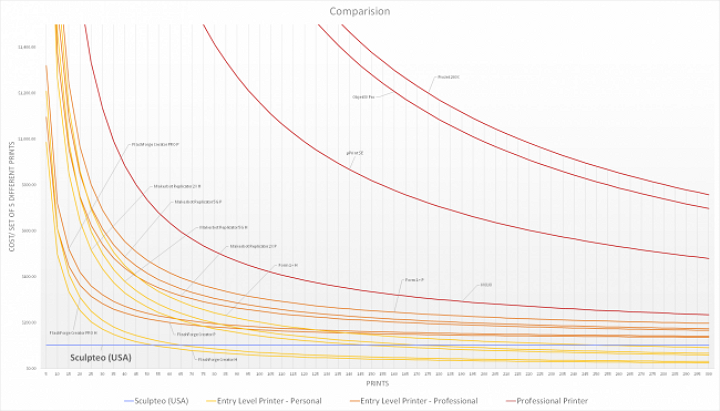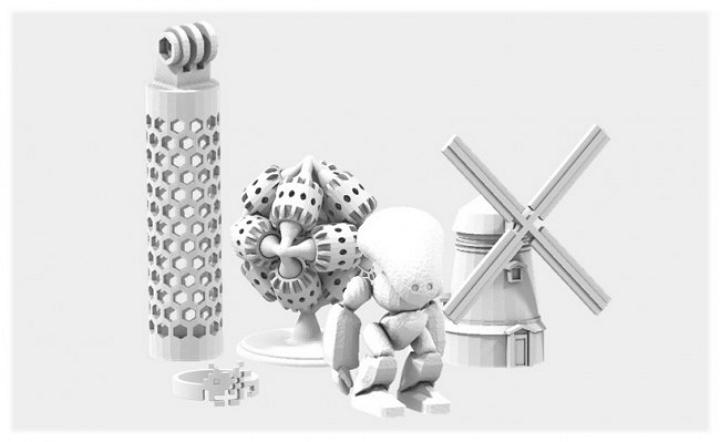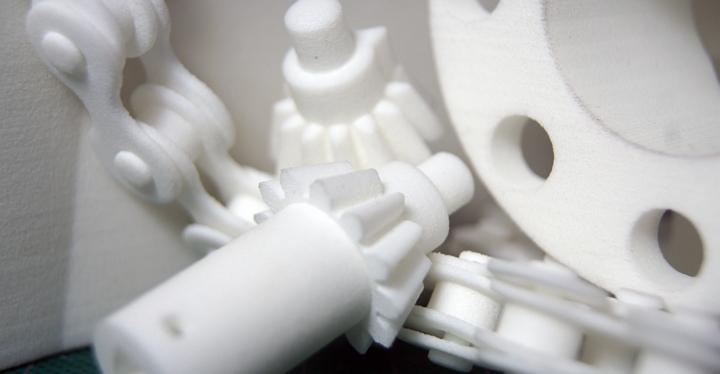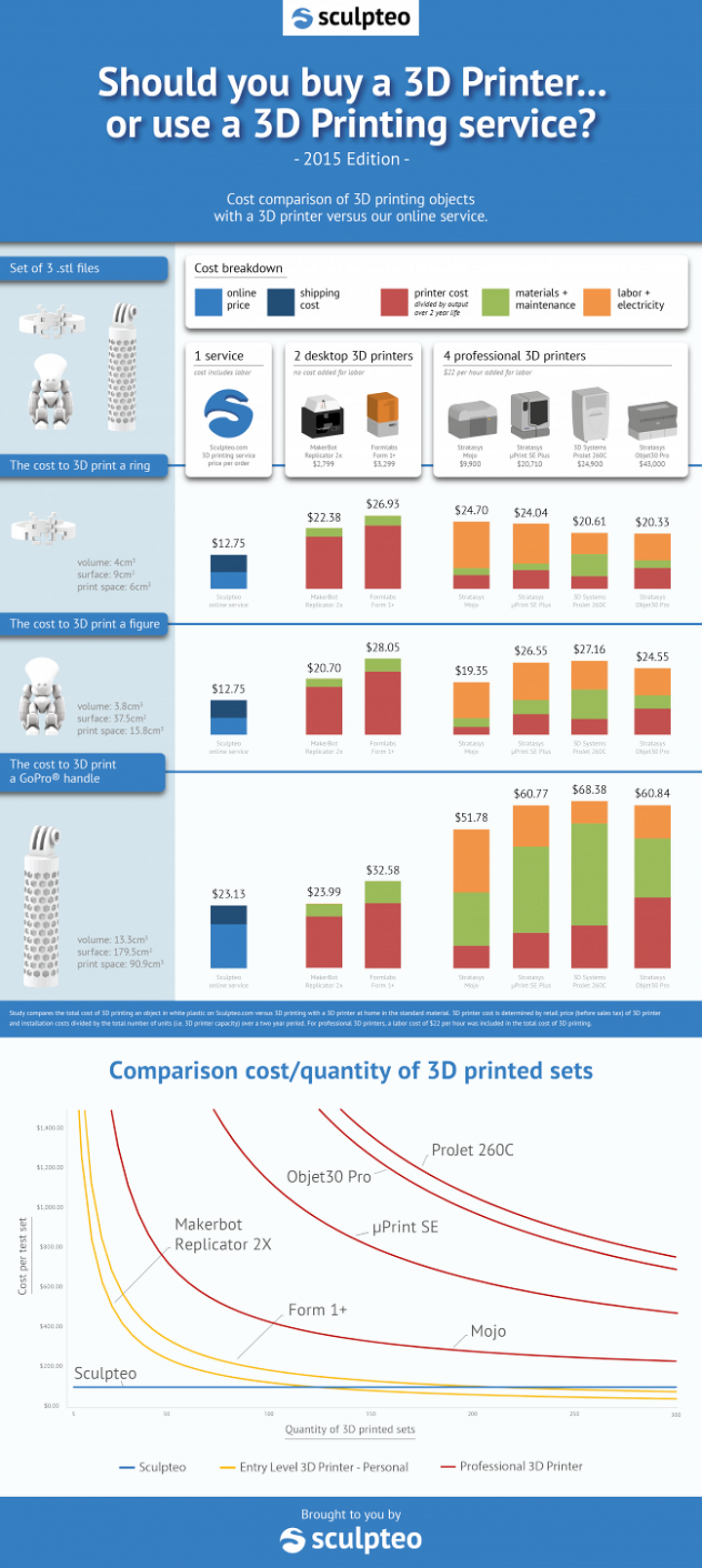With another year gone by, Sculpteo has now revisited a study they did about the cost of 3D printing for both personal and professional applications, and this updated – and improved – version takes into account a wide range of factors and considerations.
The new study begins on a basic level with an examination of how 3D printing technologies have evolved over the past calendar year. While the study uses last year’s printers, it also considers any newer versions of those printers where that applies.
 Sculpteo takes on the task by analyzing the cost to produce an individual object. The study does so by considering any investment necessary, the cost of consumables and workforce costs, and then divides that figure by the number of objects printed over a three-year period. It includes the current price of a printer plus installation costs, maintenance and replacement parts over the period, prices of consumables, and the charge due to having a person in charge of the printing process for professional uses at €20 per hour.
Sculpteo takes on the task by analyzing the cost to produce an individual object. The study does so by considering any investment necessary, the cost of consumables and workforce costs, and then divides that figure by the number of objects printed over a three-year period. It includes the current price of a printer plus installation costs, maintenance and replacement parts over the period, prices of consumables, and the charge due to having a person in charge of the printing process for professional uses at €20 per hour.
Readers also suggested that shipping rates should be added in and that a “hypothetical customer” used to calculate the figures should be based in the US.
The new analysis uses a paradigm where a desktop printer user prints just one object per job.
For each selected printer, the study considered personal or professional uses and workloads.
The printers listed in the study were the MakerBot Replicator 2X, the Form 1+, the Stratasys Mojo, the Stratasys µPrint SE, the 3D Systems ProJet 260C, the Stratasys Objet30 Pro PolyJet, and a Sculpteo service representative.
In one scenario, for example, the study based conclusions on a user who creates 52 prints per year, and they say the question for a potential 3D printer owner is then, “Am I going to be printing steadily every single week during a 3 year period?”
There is also consideration given to the surface quality of various printing methods, and the study places Selective Laser Sintering (SLS) and Stereolithography (SLA) at an advantage there as smoother finish quality means less post-production is required than for objects created with FDM or FFF techniques. Objects printed with SLS also offer the advantage of not requiring large overhangs compared with FDM or SLA.
Material costs were calculated individually for each of five designs, and maintenance costs were estimated based on the experience of actual users, and they ranged from 5% to 50% of the cost of the printer and were then divided by the number of objects printed.
 The five designs selected were the Space Invader ring by Geekrings, the Robot figurine by Emmanuel Eymond, a GoPro camera grip mount by Fabrice, a Windmill by fclem33, and the Brain Gear by mitchlee11.
The five designs selected were the Space Invader ring by Geekrings, the Robot figurine by Emmanuel Eymond, a GoPro camera grip mount by Fabrice, a Windmill by fclem33, and the Brain Gear by mitchlee11.
A comprehensive analysis, the study essentially found that while there are options available for those who need extremely cheap prints, and options for people with unrestricted budgets aiming for very high quality, online services like Sculpteo can still offer elements from both categories. They also note that services have the additional benefit of not requiring ownership of complicated devices.
If you’re the sort who digs spreadsheets, the team at Sculpteo built one that includes a bunch of information used to create this analysis, and you can download it here.
So are you better off using a service or buying a printer? We leave that to you to decide after digging through the spreadsheet in your free time.
Where do you fit in on the Buy versus Order spectrum to get your 3D printed objects completed? Let us know in the Buy a 3D Printer or Order Prints Made forum thread on 3DPB.com.
Subscribe to Our Email Newsletter
Stay up-to-date on all the latest news from the 3D printing industry and receive information and offers from third party vendors.
Print Services
Upload your 3D Models and get them printed quickly and efficiently.
You May Also Like
Consolidation in AM: How 2025 Is Shaping the Industry’s New Normal
The first half of 2025 has been marked by a clear shift in the additive manufacturing (AM) industry. Companies are no longer just focused on developing new tech by themselves....
Etsy Design Rule Change Reduces Selection of 3D Printed Goods
Online marketplace Etsy has implemented a rule change requiring all 3D printed goods on the site to be original designs. The update to the site’s Creativity Standards states, ¨Items produced using...
U.S. Congress Calls Out 3D Printing in Proposal for Commercial Reserve Manufacturing Network
Last week, the U.S. House of Representatives’ Appropriations Committee moved the FY 2026 defense bill forward to the House floor. Included in the legislation is a $131 million proposal for...
Transforming From Tourist to Native: Duro CEO Michael Corr Explains Why the Company Rebuilt its PLM Software on AI
In these early innings of the AI boom, many market analysts have expressed concern that AI spend has gotten too far ahead of the technology’s proven ability to deliver significant...


































